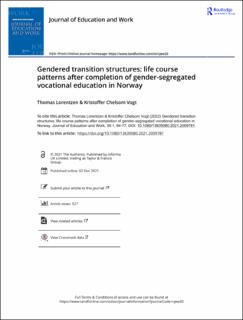Gendered transition structures: life course patterns after completion of gender-segregated vocational education in Norway
Journal article, Peer reviewed
Published version

Åpne
Permanent lenke
https://hdl.handle.net/11250/2992116Utgivelsesdato
2022Metadata
Vis full innførselSamlinger
- Department of Sociology [429]
- Registrations from Cristin [9791]
Sammendrag
In this article, we present the results from a sequence analysis of two cohorts of young people skilled in gender-segregated vocational education in Norway. By using administrative data on monthly statuses in education, employment and welfare, we map life course trajectories during the 11 years after completion. The results suggest that men skilled in male-dominated trades experience the most favourable trajectories in terms of labour market inclusion and income progression, whilst women skilled in female-dominated tracks have the least favourable trajectories. More surprisingly, the two gender minorities appear to ‘meet in the middle’, displaying strikingly similar life course pattern. We interpret these results as indicating gendered transition structures which confront vocationally inclined youth. Though we cannot draw conclusions concerning underlying selection processes, our findings may inform discussions on why young men overall have remained more reluctant towards taking gender-untraditional paths through education and employment over recent decades.
